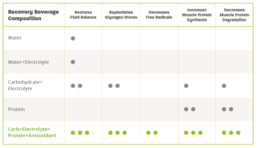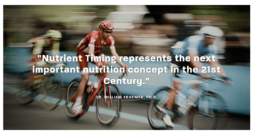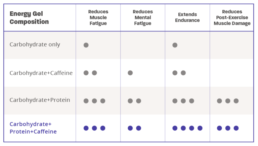Performance
In the last two decades, there has been a revolution on nutrition’s role in improving exercise performance. Earlier research focused on the amount and type of nutrition to consume when exercising. Studies conducted at the Human Performance Laboratory at Ball State University almost 4 decades ago documented the important role carbohydrate plays in improving performance and carbohydrate consumption has become an integral part of any training program.
In 1997, a landmark book, Nutrient Timing, was published by renowned exercise scientists Drs. John Ivy and Robert Portman. Nutrient Timing presented strong evidence that when you consume nutrition during exercise, may be even more important than what you consume. Nutrient Timing has shaped nutritional guidelines for athletes at all levels. Conclusive research shows that by applying the principles of nutrient timing, an athlete can deliver the precise amounts of nutrients at precisely the right time to optimize muscle growth and enhance endurance performance.
There are three distinct intervals around a workout or exercise routine. The period beginning 30 minutes before exercise, the period continuing throughout exercise, and the period after exercise has ended. These intervals collectively are called the performance zone.

Recovery

Come Back Stronger
Few areas have of science have undergone as dramatic a change in thought and practice as post exercise nutrition. Over the last 15 years, science has shown that recovery nutrition should be an essential part of the exercise regimen for athletes at all levels, professionals to weekend warriors, in all sports. Endurox® R4®, with its patented 4:1 carb- protein ratio revolutionized the science of muscle recovery.
The impetus for recognizing the role recovery plays in enhancing exercise performance was the publishing of Nutrient Timing by Drs. John Ivy and Robert Portman. The authors showed that specific metabolic pathways are activated in the 45 minutes after exercise. Consuming the right combination of nutrients during this recovery window can dramatically improve the quality and strength of muscle recovery.
Ideally the best recovery beverage should address all of these conditions but as shown in the table below many do not in spite of their widespread use following exercise. The most important factor to keep in mind when selecting the type of recovery drink is during the recovery window following exercise the metabolic pathways responsible for rehydrating rebuilding, repair and replenishment are activated. All that is needed is the right nutrient combination. The right nutrient combination consumed in the recovery window can significantly impact the rate, completeness and speed of recovery, and this translates into a better workout the next day.
How Recovery Beverages Compare


The 30W15 Rule
Scientific studies clearly demonstrate that the right combination of fluid and nutrients consumed within the performance zone will help improve athletic performance far more than the latest high-tech equipment or training device. Think of it as the 30W15 rule. Start your nutrition 30 minutes before you exercise, continue throughout your workout, and consume your recovery nutrition within 15 minutes after your workout ends. The subsequent sections will show you how to optimize Hydration/Fueling, Energy, and Recovery in the Performance Zone.
Energy

Carbo-loading
In the 60’s and 70’s, carbo-loading was the rage. Athletes consumed a large carbohydrate meal, or better yet, initiated a regimen 7-10 days before a race, in which they loaded up on carbs. The purpose was to fully pack muscle cells with glycogen. This very popular pre-race regimen lost favor when researchers showed that consumption of high-glycemic sugars during a workout or race was just as effective and a lot less complicated. Consumption of high-glycemic carbohydrates like energy gels, raises blood glucose levels which can easily be transported into the muscle and used as energy. Energy gels were an innovation in that they are easily transportable and convenient to use. For energy gels to be used most effectively, they should be consumed with water.
In a similar evolution to sports drinks, the first and still the predominant energy gels contain high-glycemic sugars. Some marketers in hopes of creating market differentiation sell gels that have low-glycemic or longer-acting carbohydrates. In theory, this sounds great. The longer-acting gels provide energy late in the workout. Unfortunately, the marketing hype does not meet the physiological reality.
The addition of protein to energy gels illustrated that even in different forms, protein offers significant benefits in terms of extending endurance and reducing post-exercise muscle damage. In a study comparing the carbohydrate-only gel, GU, to a carb-protein gel, the carb-protein gel increased endurance by 13% and decreased muscle damage by 50%.
How Nutrient Composition Impacts Effects Gel Performance

